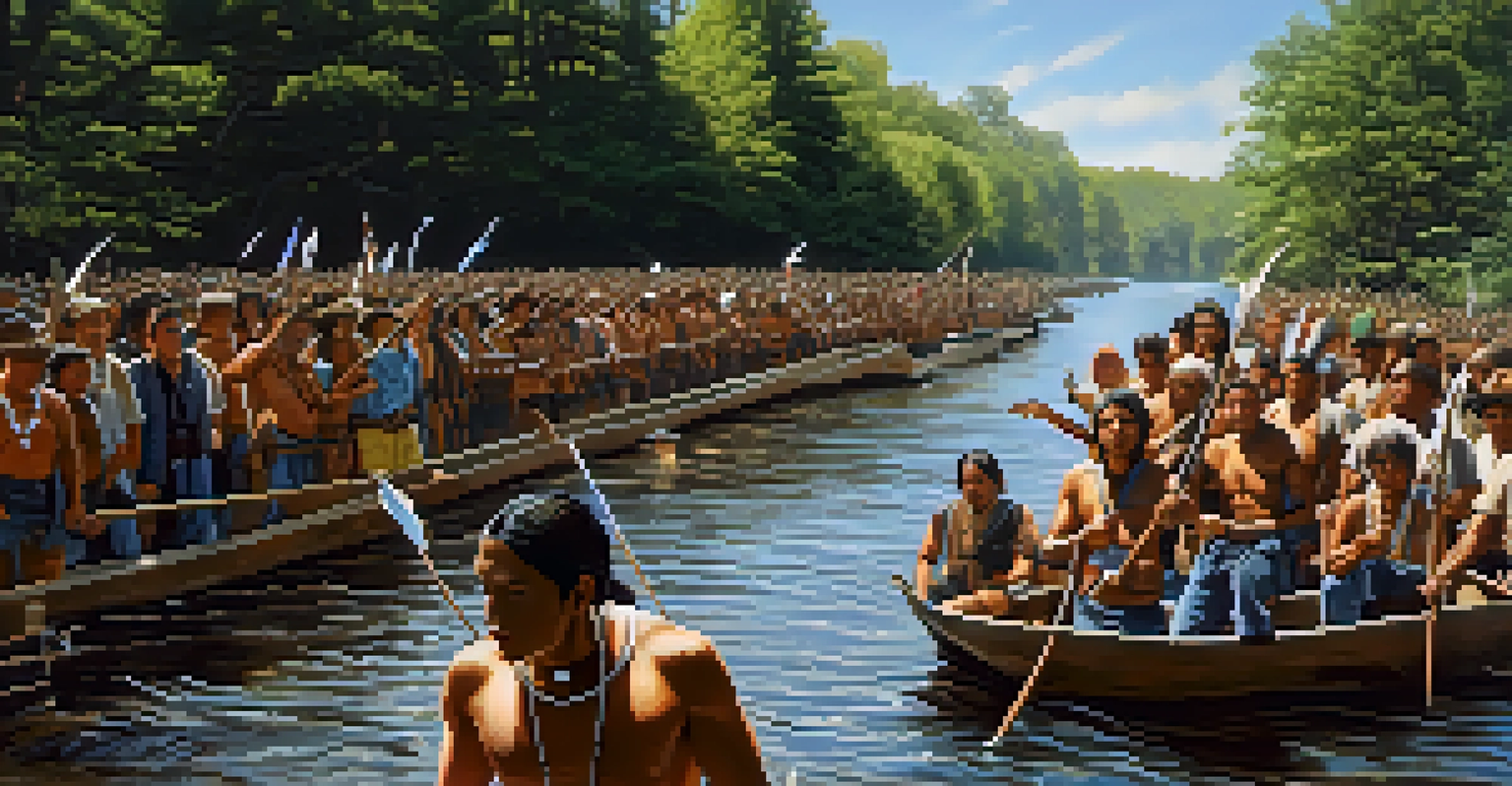Famous Indigenous Leaders in Washington's History

Chief Seattle: The Voice of the Duwamish People
Chief Seattle, a prominent leader of the Duwamish and Suquamish tribes, is perhaps the most iconic Indigenous figure in Washington's history. He is best known for his eloquent speeches advocating for the rights of Native Americans and the environment. His famous address, often associated with a deep respect for nature, reflects his profound understanding of the interconnectedness of life.
We do not inherit the earth from our ancestors; we borrow it from our children.
Seattle’s leadership during the turbulent times of the mid-19th century showcased his commitment to peace and negotiation, particularly during the encroachment of settlers on Indigenous lands. He negotiated treaties, although many were later broken, underscoring the challenges faced by Indigenous leaders of his time. His legacy continues to resonate, inspiring contemporary movements for Indigenous rights and environmental stewardship.
The city of Seattle is named after him, serving as a reminder of his influence and the history of the land. His story is not just about loss but also about resilience and advocacy, making him a pivotal figure in understanding Washington's Indigenous heritage.
Billy Frank Jr.: A Modern Warrior for Tribal Rights
Billy Frank Jr. was a Nisqually tribal leader and a fierce advocate for Indigenous fishing rights. His activism during the Fish Wars of the 1960s and 1970s brought national attention to the struggles faced by Native Americans in securing their treaty rights. Through peaceful protests and civil disobedience, Frank challenged the state’s regulations that restricted tribal fishing.

Frank’s efforts resulted in significant legal victories, notably the landmark Boldt Decision of 1974, which affirmed the tribes' rights to fish in their usual and accustomed places. His work not only transformed the fishing landscape for Indigenous communities but also set a precedent for future legal battles regarding tribal sovereignty. His legacy is a testament to the power of grassroots activism and the importance of standing up for one’s rights.
Indigenous Leaders Shaped History
Prominent figures like Chief Seattle and Billy Frank Jr. have significantly influenced Indigenous rights and environmental advocacy in Washington.
Beyond his legal battles, Frank was also dedicated to educating the public about Native American culture and rights. He founded the Northwest Indian Fisheries Commission, which continues to advocate for sustainable fishing practices, embodying his lifelong commitment to preserving Indigenous heritage and the environment.
Marie Watt: The Artist and Activist
Marie Watt is a contemporary artist of Seneca and European descent, known for her powerful work that reflects Indigenous themes and narratives. Through her art, she engages with history, culture, and identity, often using materials that connect to the natural world and Indigenous experiences. Her installations and sculptures invite viewers to reflect on the past while considering the ongoing struggles of Indigenous peoples.
The power of grassroots activism is that it can change minds and policies, and create a collective vision for a better world.
Watt’s work often incorporates blankets, symbolizing warmth, community, and the sharing of stories. By transforming these everyday objects into art, she highlights the importance of tradition and the power of storytelling in Indigenous cultures. Her exhibitions often serve as platforms for dialogue about Indigenous issues, bridging the gap between art and activism.
In addition to her artistic contributions, Watt is an advocate for Indigenous rights and representation in the arts. She encourages future generations of Indigenous artists to explore their identities and create work that speaks to their experiences, ensuring that their voices are heard in a broader cultural context.
Chief Joseph: The Reluctant Leader of the Nez Perce
Chief Joseph, also known as Hin-mah-too-yah-lat-kekt, was the leader of the Nez Perce tribe during a critical period of conflict with the United States government in the late 19th century. His leadership came to prominence during the Nez Perce War of 1877, when he sought to lead his people to safety away from encroaching settlers. Joseph's strategic skills and commitment to non-violence made him a respected figure among both his people and his adversaries.
His famous surrender speech, in which he expressed his deep sorrow for the suffering of his people, resonated widely and remains a poignant reminder of the struggles faced by Indigenous communities. Chief Joseph’s eloquence and dignity in the face of adversity have made him an enduring symbol of Indigenous resistance and resilience.
Legacy of Resilience and Advocacy
The stories of these leaders highlight the ongoing struggles and triumphs of Indigenous peoples, inspiring future generations to continue the fight for justice.
Even after his surrender, Joseph continued to advocate for the rights of his people, seeking to promote peace and understanding between Native Americans and the U.S. government. His legacy is one of courage and compassion, reminding us of the complexities of leadership during times of oppression.
Wilma Mankiller: A Pioneer of Native American Leadership
Wilma Mankiller was the first female chief of the Cherokee Nation, serving from 1985 to 1995. Though her leadership was not based in Washington state, her influence extended to Indigenous communities across the country, including those in Washington. Mankiller championed self-determination and empowerment for Native Americans, advocating for social justice and economic development.
Mankiller's tenure was marked by significant improvements in community health, education, and economic opportunities for the Cherokee Nation. She believed in the power of grassroots activism and community involvement, which inspired many Indigenous leaders in Washington and beyond to pursue similar paths. Her emphasis on collaboration and community-led initiatives set a standard for future leadership.
In her post-chief years, Mankiller continued to be a voice for Indigenous rights and women’s issues, sharing her story and experiences to inspire others. Her legacy lives on, celebrating the potential of Indigenous women in leadership roles and the importance of advocating for Indigenous rights.
John Ross: The Voice of the Cherokee Nation
John Ross, a prominent leader of the Cherokee Nation, played a crucial role in the early 19th century during a tumultuous period of forced removal known as the Trail of Tears. Though primarily associated with the southeastern United States, his advocacy and leadership had ripple effects reaching Indigenous communities in Washington as they faced similar challenges. Ross fought tirelessly against the injustices faced by his people, seeking to uphold their rights and sovereignty.
His efforts included legal battles to protect Cherokee land and culture, using diplomacy to negotiate with the U.S. government. Ross's ability to articulate the needs and rights of his people made him a respected figure not only among the Cherokee but also among other Indigenous leaders. His commitment to justice and equality set a powerful example for future generations.
Importance of Cultural Heritage
The diverse experiences and contributions of Indigenous leaders emphasize the need to honor and preserve Indigenous culture and history.
Even in the face of adversity, Ross remained dedicated to preserving Cherokee heritage and fostering a sense of unity among Indigenous peoples. His legacy is one of resilience, reminding us of the strength found in community and the importance of standing up against oppression.
The Legacy of Indigenous Leaders in Washington
The history of Indigenous leaders in Washington is rich and complex, reflecting the diverse cultures and experiences of Native peoples. From Chief Seattle’s eloquence to Billy Frank Jr.'s activism, these leaders have shaped not only their communities but also the broader narrative of American history. Their stories remind us of the ongoing struggles and triumphs of Indigenous peoples, emphasizing the importance of recognizing their contributions.
As we reflect on these figures, it becomes clear that their legacies extend beyond their lifetimes. They serve as sources of inspiration for contemporary Indigenous activists and leaders who continue to fight for rights, recognition, and respect. Their work has paved the way for future generations to advocate for their communities and preserve their cultures.

Honoring these leaders is essential in understanding the past and shaping a more equitable future. By uplifting their stories and contributions, we can foster greater awareness and appreciation for the rich tapestry of Indigenous history in Washington and beyond.